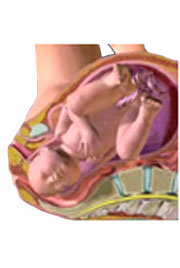Introduction to labour

Stages of labour
There are three distinct stages of labour:
- First stage – dilation of the cervix.
- Latent phase (0-4 cm dilated)
- Active phase (4-10cm dilated)
- Second stage – fully dilated till expulsion of the foetus
- Descent of the head
- Pushing phase
- Third stage – following expulsion of the foetus till the placenta and membranes are delivered.
The entire process of labour and vaginal birth takes an average of 13 hours in women giving birth for the first time, and 8 hours in women who have given birth before. However, the exact duration varies a great deal from one woman to another. 18 hours of first stage is considered ‘prolonged’, and 1.5-2 hours of second stage is considered ‘prolonged’.
Stage 1 – Cervical dilation
Stage one lasts from the initiation of labour until there is full dilation of the cervix. The cervix will become thinner (a process known as effacement) and stretches (dilation) as the baby’s head will descend and “engage” with the pelvis. This process of contractions, thinning and stretching is usually painful for the mother. First stage is generally the longest stage. In a woman who is having her first baby, this first stage takes on average 8 hours. In a woman who has had previous children, this stage will be shorter, and takes on average 4 hours.
The first stage is divided into two parts:
- The latent phase, which is defined as period between the start of labour up until the cervix is 4cm dilated. This latent phase tends to be slow, lasting an average of around 6 hours for a first baby, and 4 to 5 hours for women who have had babies before, though it may last up to 8 to 12 hours.
- The active phase is from 4cm of cervical dilation until the cervix is fully dilated (10cm). During the active phase, it is expected that the cervix should dilate at least 1cm an hour in women who are having their first baby. The cervix in women who have had a previous vaginal birth tends to dilate more quickly (about 2cm/hr). During the first stage of labour, the midwife or doctor will regularly do a vaginal examination to assess how dilated the cervix is, how the baby is descending, and the colour of the amniotic fluid. This is done at least every four hours, or more regularly if necessary. The descent of the foetus through the birth canal is also tracked by examining the abdomen. The baby is monitored either intermittently or continuously using a CTG for signs of distress.
Book your health appointments online
Find and instantly book your next health appointment with Healthengine
Stage 2 – Expulsion

-
The initial part is a passive (descent) phase; where the baby’s head moves down through the mother’s vagina.
- This is followed by an active phase where the mother feels the desire to push.
This urge to push is usually less strong if the woman has an epidural. The pushing involves contracting the abdominal muscles in time with each uterine contraction. Pushing usually comes instinctively so there is no need to worry about “not knowing how to push”, however, it is important to push in time with uterine contractions to maximise efficiency and minimise fatigue.
In a woman who has had children previously, this active “pushing” phase takes on average 20 mins. In a woman who is having her first baby, the active phase takes an average of 40 mins.
Once the baby is delivered, the umbilical cord will be clamped and cut by the midwife/doctor. The stump shrivels up in a few days to form the belly button. The baby is then free to be held by the mother.
Breastfeeding soon after delivery is often encouraged as this may assist with the third stage of delivery and is beneficial to the baby.
Stage 3 – Delivery of the placenta
The third stage lasts from the delivery of the baby till delivery of the placenta and membranes (afterbirth). Third stage may be:
- Active: the doctor or midwife gives a drug (oxytocin) via an injection into the mother’s thigh just as the baby’s head is crowning (widest part coming through the vaginal opening) to help the uterus contract down to speed up delivery of the placenta, and they gently pull on the cord of the placenta to help deliver it. Active management of third stage is faster (around 5-10 minutes) and has been shown to reduce blood loss after delivery, so many hospitals prefer to use this method; or
- Physiological: No drugs or pulling on the placenta. The placenta delivers without assistance, or with gentle pushing from the mother. This takes a bit longer than active third stage (up to 30 minutes).
After the placenta is expelled, continued contractions of the uterus constrict the uterine blood vessels. This prevents extensive blood loss. Most women will lose some blood during the delivery process – this is expected. When there are larger volumes of blood lost, a midwife or doctor may need to manage this (see Post Partum Haemorrhage).
More information
 |
For information on birthing statistics,various birthing types and other information related to giving birth, see Birth. |
References
-
Symonds E, and Symonds I. Essential Obstetrics and Gynaecology. 4th ed. Oxford: Churchill Livingstone; 2003.
-
Enkin M et al. A guide to effective care in pregnancy and childbirth. 4th ed.Oxford: Oxford University Press; 2000.
-
Sweet B, Tiran D. Mayes Midwifery: A textbook for midwives. 13th ed. Bailliere Tindall; Oxford: 1997.
-
Impey L. Obstetrics and Gynaecology 2nd ed. Blackwell Publishing Ltd: Massachusetts; 2004.
-
Sherwood LS. Human physiology – from cells to systems. 5th ed. Belmont: Brooks/Cole – Thomson Learning; 2004.
All content and media on the HealthEngine Blog is created and published online for informational purposes only. It is not intended to be a substitute for professional medical advice and should not be relied on as health or personal advice. Always seek the guidance of your doctor or other qualified health professional with any questions you may have regarding your health or a medical condition. Never disregard the advice of a medical professional, or delay in seeking it because of something you have read on this Website. If you think you may have a medical emergency, call your doctor, go to the nearest hospital emergency department, or call the emergency services immediately.







